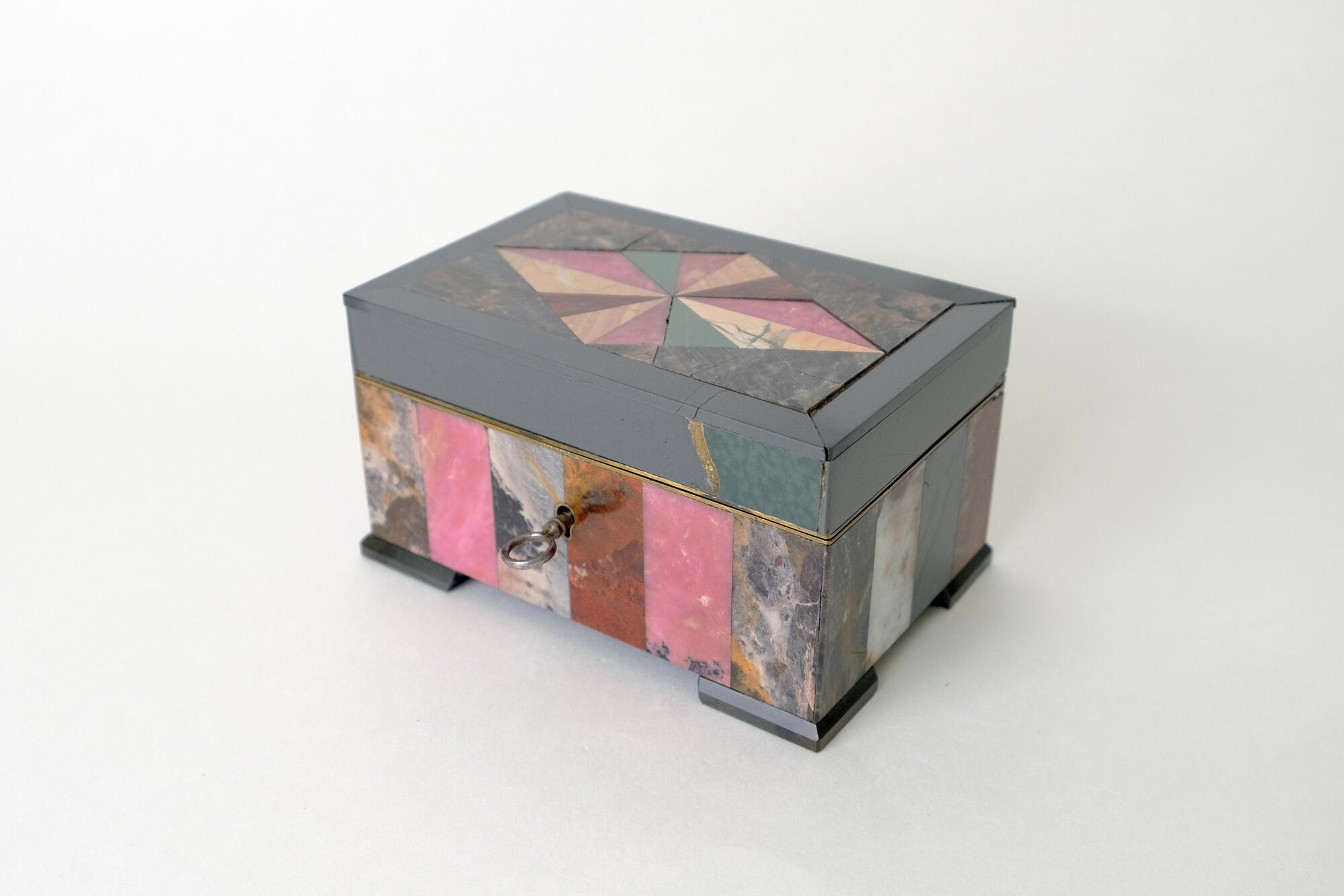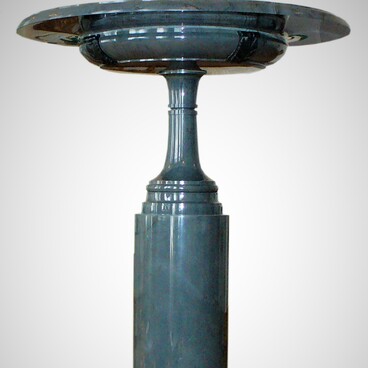The decorated rectangular box created in the Florentine mosaic technique was made at the turn of the 19th century, in the private workshop of Vasily Lipin in Yekaterinburg. The plates of jasper, rhodonite, and marble make up a geometric rhomboidal pattern on the lid and alternate with colored stripes on the sides. There is an internal lock mechanism with a key on the front side. The bottom of the box is metal. The lid is covered with pink satin on the inside. The inscription is visible on it: “The Granite workshop of V. Lipin”.
Vasily Lipin was born on January 13, 1856, in Yekaterinburg, in the family of a master of the Imperial Lapidary Factory. At the age of 21, he was drafted for military service. Then Lipin became a lapidary specialist, and in 1899 he opened his own jewelry workshop. He advertised his business in local newspapers and reference books — invited citizens to excursions. It was possible to visit the “workshop where we cut colored stones” from 8 a.m. to 7 p.m. every day, except for holidays. Guests could see and buy gold and silver items with inserts made of Ural precious stones, souvenirs made of ornamental ones, and other products.
The Sverdlovsk Regional Museum of Local Lore to this day houses sketches from the 1890s, on the back of which one can see the stamp “Shop of Ural stones, stone and gold items of V. I. Lipin”. Hairpins, pendants, hairgrips, cufflinks, and rings with inserts of precious stones are depicted on these sketches.
Vasily Lipin’s workshop was involved in designing one of the most famous works of the Imperial Lapidary Factory — a mosaic map of 1900 France. It was made specifically for the World Exposition in Paris. Details made of colored stones were fixed on the marble base, and represented the departments of France. Rivers on the map were marked with strips of platinum, and large cities were marked with inserts of cut stones. The names were written in gold lettering.
The same pair of initials — “IA” and “VL” — has been preserved on many gold inscriptions of this map. The first one belonged to the manager of the Kazan Hallmarking District Ivan Ado, the second — to Vasily Lipin. Researchers also found that the stones used for outlining the cities were cut in Lipin’s workshop.
Vasily Lipin was born on January 13, 1856, in Yekaterinburg, in the family of a master of the Imperial Lapidary Factory. At the age of 21, he was drafted for military service. Then Lipin became a lapidary specialist, and in 1899 he opened his own jewelry workshop. He advertised his business in local newspapers and reference books — invited citizens to excursions. It was possible to visit the “workshop where we cut colored stones” from 8 a.m. to 7 p.m. every day, except for holidays. Guests could see and buy gold and silver items with inserts made of Ural precious stones, souvenirs made of ornamental ones, and other products.
The Sverdlovsk Regional Museum of Local Lore to this day houses sketches from the 1890s, on the back of which one can see the stamp “Shop of Ural stones, stone and gold items of V. I. Lipin”. Hairpins, pendants, hairgrips, cufflinks, and rings with inserts of precious stones are depicted on these sketches.
Vasily Lipin’s workshop was involved in designing one of the most famous works of the Imperial Lapidary Factory — a mosaic map of 1900 France. It was made specifically for the World Exposition in Paris. Details made of colored stones were fixed on the marble base, and represented the departments of France. Rivers on the map were marked with strips of platinum, and large cities were marked with inserts of cut stones. The names were written in gold lettering.
The same pair of initials — “IA” and “VL” — has been preserved on many gold inscriptions of this map. The first one belonged to the manager of the Kazan Hallmarking District Ivan Ado, the second — to Vasily Lipin. Researchers also found that the stones used for outlining the cities were cut in Lipin’s workshop.



